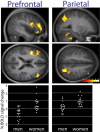Sex-based differences in the behavioral and neuronal responses to food
- PMID: 20096712
- PMCID: PMC2826550
- DOI: 10.1016/j.physbeh.2010.01.008
Sex-based differences in the behavioral and neuronal responses to food
Abstract
Sex-based differences in food intake related behaviors have been observed previously. The objective of this study was to examine sex-based differences in the behavioral and neuronal responses to food. 22 women and 21 men were studied. After 6 days of controlled eucaloric feeding, ad libitum energy intake (EI) was measured for 3 days. Appetite ratings using visual analog scales were obtained before and after each meal. Functional magnetic resonance imaging was performed in the overnight fasted state on the last day of eucaloric feeding while subjects were presented visual stimuli of food and neutral non-food objects. While hunger and prospective consumption were not different between sexes, women had higher post-meal satiety ratings and dietary restraint than men. Images of hedonic foods resulted in significantly greater activation of lateral and dorsolateral prefrontal cortex (DLPFC) and parietal cortex in women as compared to men. No brain regions were more activated in men as compared to women. Men increased their EI during the ad libitum diet phase. While measures of appetite or feeding behaviors did not correlate with either neuronal activation or subsequent EI, DLPFC activation in response to hedonic foods was negatively correlated with EI. In summary, greater prefrontal neuronal responses to food cues in women may suggest increased cognitive processing related to executive function, such as planning, guidance or evaluation of behavior. Finally, increased DLPFC activation, perhaps relating to inhibitory cognitive control in response to food cues may be a better predictor of food intake than behavioral measures.
(c) 2010 Elsevier Inc. All rights reserved.
Similar articles
-
Effects of overfeeding on the neuronal response to visual food cues.Am J Clin Nutr. 2007 Oct;86(4):965-71. doi: 10.1093/ajcn/86.4.965. Am J Clin Nutr. 2007. PMID: 17921372 Clinical Trial.
-
Differences in the neuronal response to food in obesity-resistant as compared to obesity-prone individuals.Physiol Behav. 2013 Feb 17;110-111:122-8. doi: 10.1016/j.physbeh.2013.01.002. Epub 2013 Jan 10. Physiol Behav. 2013. PMID: 23313402 Free PMC article.
-
The effects of exercise on the neuronal response to food cues.Physiol Behav. 2012 Feb 28;105(4):1028-34. doi: 10.1016/j.physbeh.2011.11.023. Epub 2011 Dec 3. Physiol Behav. 2012. PMID: 22155218 Free PMC article. Clinical Trial.
-
Appetite and energy balancing.Physiol Behav. 2016 Oct 1;164(Pt B):465-471. doi: 10.1016/j.physbeh.2016.03.038. Epub 2016 Apr 6. Physiol Behav. 2016. PMID: 27059321 Review.
-
Homeostatic regulation of food intake.Clin Res Hepatol Gastroenterol. 2022 Feb;46(2):101794. doi: 10.1016/j.clinre.2021.101794. Epub 2021 Sep 1. Clin Res Hepatol Gastroenterol. 2022. PMID: 34481092 Free PMC article. Review.
Cited by
-
Dishonesty is more affected by BMI status than by short-term changes in glucose.Sci Rep. 2020 Jul 22;10(1):12170. doi: 10.1038/s41598-020-68291-w. Sci Rep. 2020. Retraction in: Sci Rep. 2021 Jan 12;11(1):1657. doi: 10.1038/s41598-020-80528-2. PMID: 32699212 Free PMC article. Retracted.
-
Neurobiological regulation of eating behavior: Evidence based on non-invasive brain stimulation.Rev Endocr Metab Disord. 2022 Aug;23(4):753-772. doi: 10.1007/s11154-021-09697-3. Epub 2021 Dec 4. Rev Endocr Metab Disord. 2022. PMID: 34862944 Free PMC article. Review.
-
A high-protein total diet replacement alters the regulation of food intake and energy homeostasis in healthy, normal-weight adults.Eur J Nutr. 2022 Jun;61(4):1849-1861. doi: 10.1007/s00394-021-02747-1. Epub 2021 Dec 20. Eur J Nutr. 2022. PMID: 34928408 Free PMC article. Clinical Trial.
-
Effects of Dietary Protein and Fiber at Breakfast on Appetite, ad Libitum Energy Intake at Lunch, and Neural Responses to Visual Food Stimuli in Overweight Adults.Nutrients. 2016 Jan 5;8(1):21. doi: 10.3390/nu8010021. Nutrients. 2016. PMID: 26742068 Free PMC article. Clinical Trial.
-
High-fat diet-related stimulation of sweetness desire is greater in women than in men despite high vegetable intake.Public Health Nutr. 2015 May;18(7):1272-81. doi: 10.1017/S1368980014001426. Epub 2014 Jul 31. Public Health Nutr. 2015. PMID: 25079560 Free PMC article. Clinical Trial.
References
-
- Baskin DG, et al. Insulin and leptin: dual adiposity signals to the brain for the regulation of food intake and body weight. Brain Res. 1999;848(1–2):114–23. - PubMed
-
- Schwartz MW. Central nervous system regulation of food intake. Obesity (Silver Spring) 2006;14(Suppl 1):1S–8S. - PubMed
-
- Berthoud HR. Mind versus metabolism in the control of food intake and energy balance. Physiol Behav. 2004;81(5):781–93. - PubMed
-
- Watts AG. Understanding the neural control of ingestive behaviors: helping to separate cause from effect with dehydration-associated anorexia. Horm Behav. 2000;37(4):261–83. - PubMed
Publication types
MeSH terms
Substances
Grants and funding
LinkOut - more resources
Full Text Sources
Medical



